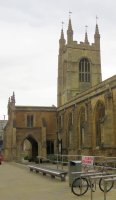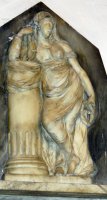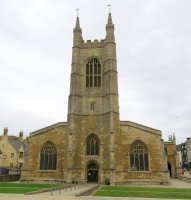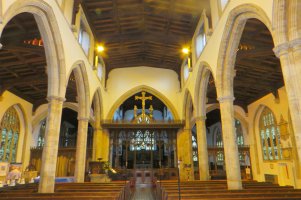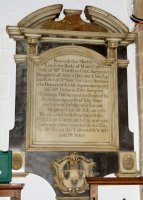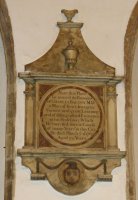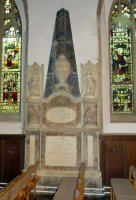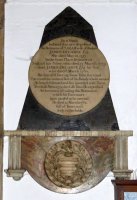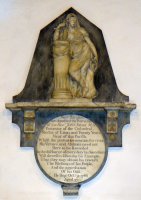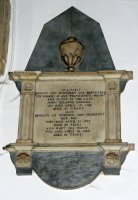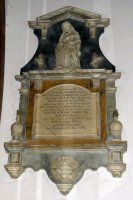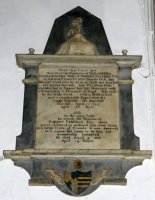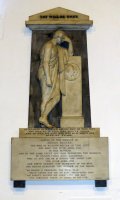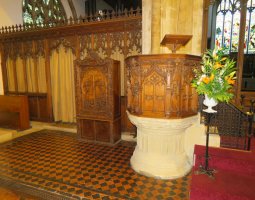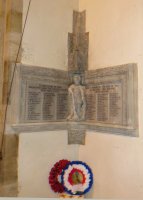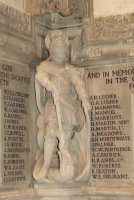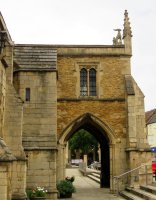Peterborough Church Monuments
St John's Church, Peterborough is a 15th Century parish church with a Victorian makeover, containing a good collection of mostly 18th Century monuments, including several locally made ones.
The church of St John the Baptist, Peterborough is a large parish church well sited at one end of the Cathedral Square. The best views are end-on. From the west, with the tall west tower and flanking aisles giving something of the aspect of a rocket ship. From the east, we have the fine Guildhall in front, and the receding battlements of nave and tower. From alongside, by contrast, the Church looks a little low compared to the height of the tower. That tower is battlemented, and has tall crocketed pinnacles at each corner, each bearing a weathervane. There is a rather splendid south porch, with open arches so you can walk straight through, and a second storey. Most of the building dates from 1402-7, including that porch, and some of the material came from a previous, 11th-12th Century church which had to be demolished due to continued flooding. There was a refurbishment in the early 19th Century, at which time the spire on top of the tower was removed, and much of the outside, though correctly Perpendicular, actually dates from a Victorian restoration by the esteemed Victorian Gothic architect J. L. Pearson in the early 1880s. Regardless, what we see from outside today is convincingly of a piece.
St John the Baptist Church.
The interior consists of a long, tall nave, separated by thin Gothic arches from the aisles, which are also tall; a clerestory is above. A modern feature is the fine early 20th Century screens across the end of the nave. With the ranks of wooden pews and the dark wooden ceiling, we have an umber, mellow ambience permeating the Church. The panel monuments hang along the nave walls, and include about 16 readily viewable ones, of which the majority are from the later 18th Century, and including some splendid polychromatic pieces with differently coloured marbles, high quality carving, and four figure-pieces. Five panels are by the interesting local sculptor Edward Bingham of Peterborough, one by Richard Hayward, born fairly locally too, and one by the eminent sculptor John Flaxman. We take them roughly in date order.
Monuments
- Mary [Delarue] Cox, d.1763, and her husband Thomas Cox, d.1788. The style is more of the earlier than than the later 18th Century, so I would tend to think it dates from after her death rather than his. A bright monument of differently coloured marbles: the inscribed panel and frame are white, with receding dark sides, and a shelf above on which sits a curved pediment of red marble, broken at the top to fit the base of some vanished shield of arms or pot. Such an upper portion to monuments on the mid to grand size are quite common from the 17th Century onwards, but rather petered out by the 1740s, so even at 1763 this one is rather late of its type. At the base of the panel is an apron (the lower part of a panel monument, between two brackets), containing a cartouche of arms, flanked by two stylised flowers carved in low relief acting as bases to the side pieces; a small shelf is at the base.
Obelisk monument to Thomas Warriner, d.1767.
- Thomas Warriner, d.1767, ‘Late a Native of the City, And one of its ancient Inhabitants, with a short homily to the Reader. A tall obelisk monument, with the inscription on a circular panel in front of the obelisk, which is unusual; it slightly overlaps the edges of the obelisk to the sides (lots more about obelisk monuments on this page). Then a shelf, and a short apron, cut with curls, with a low relief shield of arms upon it. Directly underneath is an unornamented circle to Thomas Warriner, d.1777, nephew of his namesake, and his wife Ann Warriner, d.1780. And under that, a curvy panel with upper shelf to Mary Ann Loftus, d.1815, whose mother was Mary Ann Warriner. The main panel is signed by Bingham, who is the local mason Edward Bingham of Peterborough. We shall see more of his work below.
Charles Balguy, d.1767.
- Charles Balguy, d.1767, in coloured marbles, mostly a beige, speckled type. The inscription on a central roundel within a square, with inclusions and spandrels of a fine red marble, receding pilasters (flat pillars) to the sides. Above, a shelf of white marble with black streaks, then a curved upper, like a small obelisk, of a darker beige marble, with small carved pot in front, and a smaller pot on the very top on a shelf; there would likely have been smaller accoutrements to the sides above the pillars, but if so, they are lost. Underneath, another shelf, then the apron, or lower part, cut to a nice wavy shape, and bearing a shield of arms carved within a roundel, with a rope around the top, hanging to the sides, then hooked over some pin and hanging down to the small brackets. The colours and general shapes are usual for the time, but the piece has some odd features, notably the Gothic detailing to the pilasters, rather unusual at this time and on a Classical monument, but discrete enough that there is no jarring to the eye. Also odd is that the monument is signed twice, again by Bingham: once on a bracket, once on the base of the central pot. I can only think the pot was made for some other monument, had the signature carved, and then it was decided to use on this piece where there was space for the signature already in a more usual place.
- William Bowker, d.1782, his son William Bowker, d.1765, and added later, his wife Frances Bowker, d.1783. On a roundel within a square of orange and black marble, with fluted pilasters to the side, oddly curving forward with squares at the top. These support a shelf with projecting sides, on which sit a pair of flaming urns. Something in the centre, presumably a coat of arms, is lost. At the base is a shelf supported on blocky brackets, with an apron between with crossed branches tied with a ribbon, carved in low relief. Our third piece by the local statuary Bingham again.
John Hayward's monument to Matthew Wyldbore, and detail.
- Matthew Wyldbore, d.1784, local MP and 'a very useful member of the Honourable Corporation of the Great Level of the Fens'. The grandest piece in the Church, with a fireplace-like lower structure in two levels, and an upper obelisk, reaching as high as the curve of the adjacent Gothic windows, bearing a flaming pot carved in relief. The obelisk is of black, grey and white marble, most striking. To either side of this are small porticos, with curly pediments and acroteria, each with a carved figure: to the left is a woman with wreath and overflowing cornucopia, symbol of Plenty (see picture at top of page), and to the right an angel with much drapery and a shield; her raised arm is broken off, but she may have held some sword for Courage. Well carved work, the figures being a little more dumpy than the normal Victorian ideal, and with rather solid arms. Beneath this, the central tier of the monument has the inscription in an oval in the middle, within an inlay square and with arms above, so that the centre of the shelf above is raised and curved. To the sides under the figures are pilasters with wavy fluting. Then another shelf below, and the third tier, with central square panel and side pilasters, and a deep base. Both these tiers ar in a red-brown marble or alabaster, with white inclusions, adding to the sense overall of colour and richness. Signed by Richard Hayward, born somewhat west of Peterborough in a village called Bulkington near to Birmingham, but resident in London by the time he made this monument. He was a sculptor of some reputation, much of his work being marble chimney pieces and other accoutrements for stately homes. He also has the distinction, according to Gunnis, the sculptural historian, of being the sculptor of the oldest surviving public statue in the USA, of Lord Botetourt, 1773, in Williamsburg, Virginia. Hayward's monuments are not numerous, but include works in Westminster Abbey and Chester Cathedral.
Delarue monument with obelisk and coloured marble base.
- James Delarue, d.1782, his wife Sarah Delarue, d.1757, his sister Sarah, d.1765, and son James Delarue, d.1780. Erected at his own wish. An obelisk monument, with the inscription on a large circular panel in front of the obelisk, and overlapping to the sides more than the Warriner monument noted above, rather uneasy on the eye. There is a shelf beneath, supported on pilasters to the sides with blocky bases serving as brackets, and in between is the apron, in an arresting red and white marble, with the carved family coat of arms upon it.
- Revd. John Image, d.1786, Precentor of Peterborough Cathedral, Rector of Etton, and 20 years Vicar of the Parish. With a standing female figure resting on a pillar (pictures below left and at top of page). She is lightly draped, very lightly, and in cross-legged lounging posture typical of the period, leaning casually on her elbow. In her free hand she holds a wreath. Behind is a short, broad obelisk of black marble. Below, a shelf, resting on brackets carved in relief with stylised flowers, scallop shells underneath. The lower part contains the inscription, unusually on a circular panel. Signed by Bingham again.
Shorter obelisk monuments.
- Ann [Delarue] Pulvertoft, d.1788, sister of James Delarue noted above, her son John Pulvertott [sic], d.1786, and his wife Mary Pulvertott, d.1790. The inscribed panel in white marble has side pilasters decorated at the tops, and an upper shelf on which rests a very short obelisk with a small pot in high relief upon it; at the base, a shelf above a shallow apron in black and white marble between two brackets, each bearing a carved, stylised flower. See picture above right. White-on-black panels began to predominate from this time and through much of the 19th Century - see this page.
Highly ornamented panel to the Sambrook family, by Bingham.
- Thomas Sambrook, d.1759, and his wife Elizabeth Sambrook, d.1783, and their son Thomas Sambrook, d.1774, and daughter Mary Sambrook, d.1795, 'at whose Desire and Sole Expence this Monument is Erected'. Another fine colourful piece. It features a nicely carved girl resting her elbow on a fluted pillar with a bit of drapery tied around, symbol of memory, and the pillar, which lacks a top, suggesting the end of the family. To either side, a flaming urn, and all this against a curvy black backing, and under an open pediment acting as a canopy to the figure. Below, a shelf separates the sculpture above from the central inscribed panel, which is on a creamy beige streaked marble, with raised top, with a surround of orange and black marble. To the sides, receding darker marble pilasters with white capitals, and in front of them, another pair of carved flaming urns. At the base, a shaped apron with lightly carved roundel of arms, and small supporting brackets with inclusions of the orange and black marble. All very colourful, and signed again by the accomplished Bingham of Peterborough, our final piece by him in the Church.
Freeman monument, with very short obelisk.
- Elizabetha Maria Editha Freeman, d.1795, and her husband Robert Freeman, d.1805. Another decorated white-on-black panel. The inscribed panel has shaped black pilasters, upper and lower shelves, and on the upper one, a short obelisk with a carving upon it of a draped pot with a withered plant growing from the top: a roughly triangular composition which rests somewhat uneasily because of the meagreness of the plant compared to the pot (see picture above, click to enlarge and see properly). To the base, a painted shield of arms and a shaped apron. We can see something of a stylistic sequence from the Delarue and Image panels through to the Pulvertoft and Freeman ones: the earlier Delarue monument has a rather widened obelisk, compared to the more usual tall, thin ones of the Warriner and Wyldbore obelisk monuments. The shape is broadened further in the Image panel, and further still in the Pulvertoft and Freeman ones, and too we see a reduction in size of the obelisk through the sequence, with the Freeman piece being more of a square panel 'fireplace' monument with the obelisk as a smallish extra on top.
- Edward Laxton, and his wife Mary Laxton, d.1799, plain tablet with upper shelf and little supports. An odd 18th Century panel, with two inscriptions one on top of the other, to Mary Exton, and some commemoration of three church wardens. An upper shelf and curly side pieces and base survive, but there would seem to have been more which is now lost.
- Wright Thomas Squire, d.1802, and his wife Lucy Eliza [Bigland] Squire, d.1820, and children Wright Thomas Squire, d.1810 and Elizabeth Squire, d.1805. Styled as a casket end monument, with the inscription on the casket, with outward sloping sides, little lion feet below, and a lid above an upper shelf or rim, on which is a neatly carved bowl with hanging drapes. Casket tombs almost always have the feet resting on a separate lower shelf as here, and in this case, that lower, broader shelf is supported on blocky brackets with carved shells upon them. With a streaky grey marble back rather than the usual black, for now we are well into the white-on-black period of panel monuments, with the use of coloured marbles ceasing for the large part of the 19th Century.
Flaxman's monument to William and Ann Squire.
- William Squire, d.1826, and his wife Ann Squire, d.1819, with a very good male figure resting, mourning, against a tall pedestal on which is a double portrait roundel carved in relief of his first wife and child, noted on a separate lower panel as Agnes Squire, d.1780, and Agnes Squire, d.1793. The male figure, then, represents William Squire after they died. He wears a Classical drape, wound round his figure as a toga, and over the arm which is propped on the top of the pedestal, the hand on his brow in an epitome of sad reflection. His sandalled feet are crossed, thus overall he echoes a typical mourning female posture of a generation earlier. Above, a heavy shelf and pediment, bearing the Biblical quote 'Thy Will be Done'. The figure is simple but very striking, and it comes as no surprise to find John Flaxman's signature on the monument.
- Rebecca Beharrell, d.1831, and her sister Anne Beharrell, d.1837. Tall panel with side pilasters, upper shelf and entablature bearing two attached flowers, and something missing from the centre; the base of the panel was hidden when I visited, and it may be there was something on top at one point.
- Samuel Brocksopp, d.1841, with an inscription regarding his charitable donations. Another blocky panel, but this time Tudor Gothic, with tall, thin pillars to the sides of black marble with Gothic uppers, and a fortified top.
Mary Cox, d.1763.
On my visit, a side chapel of the Church was locked up, but I could see through the glass some small number of further monumental panels, including a large one to John Cox, d.18?? and his wife Ann Cox d.1835 with pillars to the side and a heavy pot on top, and an small white-on-black panel to Mary Cox, d.1848.
Also in the Church:
- Floor tiles along the nave and in a big panel around the pulpit. Nothing pictorial, but the black and deep orange pattern, with the adjacent font, cupboard and screen, adds to the warm, glowing atmosphere of this part of the Church.
- The font, octagonal with quatrefoils on each side, and more minor carved ornamental flowers below, 15th Century. Little Gothic arches on the stem. The cover is an open Gothic tracery design, most effective. Picture above.
- The pulpit: wooden, hexagonal on a massive stone base. With carved figures of the four Evangelists in niches and a profusion of fruit and leaves above in fine Victorian Gothic style. By it is a cabinet for liturgical clothing, dated 1569, but according to Historic England, likely composed from partial remains of several older Continental pieces in the 19th or 20th Century. Both are pictured above, along with some of the floor tiles - click to enlarge and see properly.
- A brass eagle lectern, with rather more bushy feathers than many, which avoids a too-shiny metal look. Good late Victorian glass, including examples with a yellowish tint which add much to the ambience of the interior.
- A wooden board listing the Vicars of Peterborough since 1229 through to the present. Gothic edgings and more decoration at the top. A brass panel noting the restoration of the Church in 1883, with the excellent John L. Pearson RA as architect. A nice border of Clematis vine.
- A further brass panel noting the restoration of the Church from 1907-9 and the contributing donors to the screens: to the memory of Andrew and Eliza Percival and to Augusta Crick.
War Memorial, and figure of St George.
- World War 1 Memorial, an angled double panel of names in a corner, with the corner position incorporating a carved figure of St George and the Dragon, in late Arts and Crafts style. He stands under a Gothic niche, and with a small spandrel below.
The Church website is at https://peterboroughparishchurch.wordpress.com/st-john/history/
Splendid south porch, 15th Century.
Also noted on these pages in Cambridgeshire: Huntingdon sculpture (with links to church monuments there).


